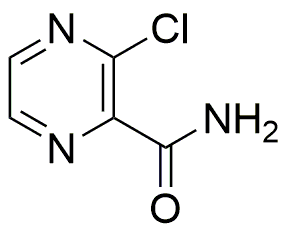3-Chloropyrazine-2-carboxamide is widely utilized in research focused on:
- Pharmaceutical Development: This compound serves as a key intermediate in the synthesis of various pharmaceuticals, particularly in the development of anti-cancer and anti-inflammatory drugs.
- Agricultural Chemistry: It is employed in the formulation of agrochemicals, enhancing the efficacy of pesticides and herbicides, thus improving crop yield and protection.
- Material Science: The compound is used in the creation of advanced materials, such as polymers and coatings, that require specific chemical properties for durability and resistance.
- Biochemical Research: It acts as a valuable reagent in biochemical assays, aiding in the study of enzyme activities and metabolic pathways, which is crucial for understanding various biological processes.
- Environmental Monitoring: 3-Chloropyrazine-2-carboxamide is utilized in analytical chemistry for detecting pollutants in environmental samples, helping to ensure compliance with safety regulations.
General Information
Properties
Safety and Regulations
Applications
3-Chloropyrazine-2-carboxamide is widely utilized in research focused on:
- Pharmaceutical Development: This compound serves as a key intermediate in the synthesis of various pharmaceuticals, particularly in the development of anti-cancer and anti-inflammatory drugs.
- Agricultural Chemistry: It is employed in the formulation of agrochemicals, enhancing the efficacy of pesticides and herbicides, thus improving crop yield and protection.
- Material Science: The compound is used in the creation of advanced materials, such as polymers and coatings, that require specific chemical properties for durability and resistance.
- Biochemical Research: It acts as a valuable reagent in biochemical assays, aiding in the study of enzyme activities and metabolic pathways, which is crucial for understanding various biological processes.
- Environmental Monitoring: 3-Chloropyrazine-2-carboxamide is utilized in analytical chemistry for detecting pollutants in environmental samples, helping to ensure compliance with safety regulations.
Documents
Safety Data Sheets (SDS)
The SDS provides comprehensive safety information on handling, storage, and disposal of the product.
Product Specification (PS)
The PS provides a comprehensive breakdown of the product’s properties, including chemical composition, physical state, purity, and storage requirements. It also details acceptable quality ranges and the product's intended applications.
Certificates of Analysis (COA)
Search for Certificates of Analysis (COA) by entering the products Lot Number. Lot and Batch Numbers can be found on a product’s label following the words ‘Lot’ or ‘Batch’.
*Catalog Number
*Lot Number
Certificates Of Origin (COO)
This COO confirms the country where the product was manufactured, and also details the materials and components used in it and whether it is derived from natural, synthetic, or other specific sources. This certificate may be required for customs, trade, and regulatory compliance.
*Catalog Number
*Lot Number
Safety Data Sheets (SDS)
The SDS provides comprehensive safety information on handling, storage, and disposal of the product.
DownloadProduct Specification (PS)
The PS provides a comprehensive breakdown of the product’s properties, including chemical composition, physical state, purity, and storage requirements. It also details acceptable quality ranges and the product's intended applications.
DownloadCertificates of Analysis (COA)
Search for Certificates of Analysis (COA) by entering the products Lot Number. Lot and Batch Numbers can be found on a product’s label following the words ‘Lot’ or ‘Batch’.
*Catalog Number
*Lot Number
Certificates Of Origin (COO)
This COO confirms the country where the product was manufactured, and also details the materials and components used in it and whether it is derived from natural, synthetic, or other specific sources. This certificate may be required for customs, trade, and regulatory compliance.


